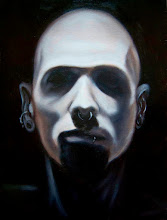OH EM GEE GUYS!!!! I ain’t dead. For real!
I was just busy, y’know, selling shoes. Painting. Stuff like
that.
THAT BEING SAID, here I am again, with something that might
be useful for you, in these days prefacing halloween. (Prefacing? Is that even
a word? Or is that a francisism or
something like that?) In any case, I’m gonna show you guys how I usually proceed
to give an antique patina to 3D objects. In this case, a sparkling new bust of
King Tut.
Nice & shiny
This bust was something a close ladyfriend bought at a
fleamarket, and she repainted it as new, but she still wanted to give it the look
& feel of something unearthed from a 3000 years old tomb.
So what I did firstly, was to open a bottle of beer. In this
case, a Shandy, by Rickard’s. It’s a pale lager with a slight lemony taste,
very refreshing. But I digress. Once I had something to drink, I simply mixed
together a drop of Burnt Umber oil paint, a drop of Ivory Black oil paint, and
my oil medium of choice, Liquin by Winsor & Newton (You can substitute the
medium of your choice). My goal was to create a creamy, easily spreadable dark
brown glaze.
Here, you can see me applying it to the bust. I’m using a
boar bristle Philbert brush; it lets me apply paint in wide strokes on one
side, but I can use the flat, rounded side to push the paint in every nook
& cranny of the bust. Use whatever floats your boat.
That is what the thing should look like once the dark glaze
has been applied all over. What you must remember is that the important part is
to make sure the glaze is brushed in every little cranny; You don’t have to
worry about how well covered the flat surfaces are. That doesn’t matter.
It doesn’t matter because you’re gonna rub it off anyways,
slowly but surely, with a soft cloth. Do not rub so hard as to remove the paint
from the recesses; Only remove it from the flat, elevated surfaces. The deeper
the area, the more paint you wanna let settle down.
Sorry for the plaid shirt and scraggly beard, I forgot to remove my official Canadian uniform.
That is what it should look like, more or less depending of
your tastes, once the superfluous paint has been removed. As you can see, it
looks like shiny, oily dirt has settled in the cracks. Shiny and oily?? That won’t
do!
Take a break, finish your beer, have dinner and move to
wine, and let the paint dry a little bit.
Afterward about 2 or 3 hours, you’ll need these :
A soft bristle brush, charcoal & a mortar and pestle (or
powdered charcoal, if you’re a spoiled brat!), yellow ochre pigment, and baby
powder.
Mix the whole thing together until you get a nice, dusty
mummy grey with a touch of dirty yellow to it. To lighten the mix, add baby
powder. To darken it, use more charcoal (duh).
You then want to brush it all over your statue with the soft
bristle brush; cover it well, don’t be afraid!
You can also ask a cute friend to do the back, because it’s
less boring if you have a cute friend to look at.
All that is left, once the whole bust has been dusted with
the powder, is to remove the excess, either with a soft cloth or the fluffy
brush. If you’ve done everything correctly, the dusty powder should stick to
the paint that has pooled in the sculpture’s recesses, giving the whole thing a
centuries old look.
Doesn’t it look like it was just dug out of a tomb? Feel
free to try this with any prop/statue that you have laying around needing a
good aging. Works like a charm, and you seriously can’t mess it up!















No comments:
Post a Comment